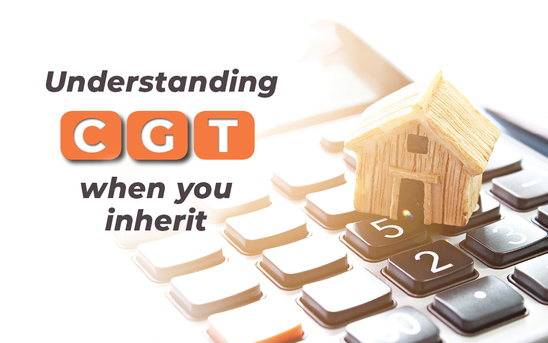Understanding CGT when you inherit

Receiving an inheritance is always welcome, but people often forget the tax man will take a keen interest in their good fortune.
When ownership of an asset is transferred, it triggers a capital gain or loss with potential tax implications. So what are the tax rules when you inherit a property, or another investment asset like shares, and when you eventually decide to sell?
Tax and your inheritance
The main tax applying to the transfer and sale of an asset is capital gains tax (CGT). This is added to your tax bill in the financial year in which you sell an asset acquired on or after 20 September 1985.
CGT is not a separate tax but forms part of your normal income tax and is imposed at your marginal tax rate. It applies to the sale of assets such as residential and investment properties, shares and managed funds.
The tax is calculated based on any increase in the value of the asset between the time you acquire or buy it and when you eventually sell.
Inheriting an asset
Fortunately, when someone dies, a capital gain or loss does not apply when an asset passes to the deceased person’s beneficiary, their executor, or from the executor to a beneficiary.
This means if you inherit a property, shares, or an interest in an investment asset, the capital gain on the asset is disregarded by the tax man.
There are also exemptions for personal use assets you inherit that were purchased for less than $10,000. This includes furniture, household items and the like.
Generally, CGT is not payable if you inherit collectables such as art, jewellery, stamps or antiques, provided their market value is $500 or less.
Selling your new asset
Although there is no CGT when you inherit a property, that’s not the end of it, as there may be a tax bill when you eventually sell. If the asset is a dwelling, special rules such as the main residence exemption apply in part or full.
Generally, if you sell an inherited property within two years of the person’s passing and it was either purchased before September 1985 or was the deceased’s main residence at the time or just before their death, and in most cases, not rented being at the time of their death, CGT does not apply.
The two-year period relates to the time from the date of death to the settlement – not exchange – of the sales contract. In some cases, it’s possible to apply to the ATO for an extension to this two-year period.
Special tax rules may also apply if the property was not the deceased’s main residence but it was purchased prior to 20 September 1985. This may result in a full or partial exemption from CGT, so it’s important to talk to us about your particular situation.
After the two-year deadline
If you decide to sell your inherited property after the two-year exemption period has elapsed, you will generally have to pay CGT on the capital gain on your property unless it has become your main residence.
The amount of CGT you pay is based on the increase in your property’s value from the date of the deceased’s death to the date of the sale.
When working out the capital gain on an inherited property asset, CGT is calculated based on the sale price less the cost base of the asset. In most cases, the cost base is equal to the market value of the asset at the date of the deceased’s death, although this will depend on when the home was purchased (before or after 20 September 1985).
If CGT applies when selling an asset, you normally receive a 50 per cent discount on the amount of tax payable if the asset is owned for over 12 months.
CGT is a complex area of taxation, especially as it applies to inheritance, so if you would like help with handling the tax matters relating to an inherited asset, contact our office today on 03 5120 1400 or click here to send through your enquiry and an adviser will be in contact.
Material contained in this publication is a summary only and is based on information believed to be reliable and received from sources within the market. It is not the intention of RGM Financial Planners Pty Ltd ABN 36 419 582 Australian Financial Services Licence Number 229471, RGM Accountants & Advisors Pty Ltd ABN 69 528 723 510 that this publication be used as the primary source of readers’ information but as an adjunct to their own resources and training. No representation is given, warranty made or responsibility taken as to the accuracy, timeliness or completeness of any information or recommendation contained in this publication and RGM and its related bodies corporate will not be liable to the reader in contract or tort (including for negligence) or otherwise for any loss or damage arising as a result of the reader relying on any such information or recommendation (except in so far as any statutory liability cannot be excluded).
Liability limited by a scheme approved under Professional Standards Legislation.
.


